
|







(alphabetical and illustrated) Introduction | A - 1 | A - 2 | B - 1 | B - 2 | C - 1 | C - 2 | C - 3 | D | E | F G - H | I - J - K | L - M | N - O | P | Q - R | S - 1 | S - 2 | T | U - V - W - X - Y - Z |
|
|
|
|
|
| the chief or head electrician or supervisory lighting technician in the film/photography crew on a movie set, responsible for the design and execution of a production's lighting plan on the set; the gaffer's right-hand assistant is known as the best boy; gaffer tape refers to multi-purpose, sticky and wide black cloth tape, used to mark studio floors, to hold things together, etc. | |||
| these are comedy films that are often
non-sensical and literally filled with multiple gags (i.e., jokes, one-liners,
pratfalls, slapstick, etc.), are designed to produce laughter in any
way possible, and often with comic or spoofing references to other films |
Examples: Mack Sennett's Keystone Kops, Mel Brooks' Blazing Saddles (1974), Airplane! (1980), the "Road movies" of Bing Crosby and Bob Hope, Hot Shots! (1991), The Naked Gun films, the Austin Powers series, and the Scary Movie series. | ||
| the aperture assembly of a camera, printer, or projector at which the film is exposed | |||
| a transparent, tinted colored sheet of plastic used as a filter for a movie light to create a colored glow over a scene, usually to evoke a desired mood. Black-and-white silent films would often physically tint film stock to achieve the same effect (see tint) |  Example:
The hellish blood-red glow seen during the infamous strip club scene
in Mean Streets (1973) Example:
The hellish blood-red glow seen during the infamous strip club scene
in Mean Streets (1973) |
||
| usually, a cross-dressing role in which a
male or female plays a character of the opposite sex |
 Examples: Some
Like It Hot (1959), The Rocky Horror Picture Show (1975), Tootsie
(1982) (pictured) - Dustin Hoffman, The Year of Living Dangerously
(1982) - Linda Hunt, Victor/Victoria (1982) - Julie Andrews, Mrs.
Doubtfire (1993) - Robin Williams, The Crying Game (1992) -
Jaye Davidson, Boys Don't Cry (1999) - Hilary Swank Examples: Some
Like It Hot (1959), The Rocky Horror Picture Show (1975), Tootsie
(1982) (pictured) - Dustin Hoffman, The Year of Living Dangerously
(1982) - Linda Hunt, Victor/Victoria (1982) - Julie Andrews, Mrs.
Doubtfire (1993) - Robin Williams, The Crying Game (1992) -
Jaye Davidson, Boys Don't Cry (1999) - Hilary Swank |
||
| a role traditionally played by a male or female that is switched and played by a member of the opposite sex; see also non-traditional casting | Examples: Rosalind Russell as Hildy Johnson (originally a male role) in His Girl Friday (1940), Judi Dench as M in the Bond series | ||
| refers to the widespread simultaneous exhibition of a film | |||
| usually refers to the number of times a videotape has been copied; third generation means three steps away from the original media master | |||
| originally a French word meaning "kind", "sort" or "type"; refers to a class or type of film (i.e., westerns, sci-fi, etc.) that shares common, predictable or distinctive artistic and thematic elements or iconography (e.g., bad guys in Westerns wear black hats), narrative content, plot, and subject matter, mood and milieu (or setting) or characters. Film genres are distinct from film styles (a recognizable group of conventions used by filmmakers to add visual appeal, meaning, or depth to their work) that can be applied to any genre; also see hybrid; anti-genre films present an apparent genre stereotype and then subvert or challenge it - see revisionistic films | 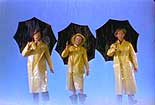 Note:
See write-up of descriptions of all types of genre films (action, adventure, gangster, sci-fi, westerns, horror, thriller, musicals, comedy, etc.).
Pictured is an example of a musical, Singin'
in the Rain (1952). Note:
See write-up of descriptions of all types of genre films (action, adventure, gangster, sci-fi, westerns, horror, thriller, musicals, comedy, etc.).
Pictured is an example of a musical, Singin'
in the Rain (1952). Revisionistic genre films: (e.g., Altman's McCabe & Mrs. Miller (1971), and The Long Goodbye (1973); Costner's Dances With Wolves (1990)) |
||
| a literary or film style characterized by dark and dreary influences, such as ghouls, the supernatural, the grotesque, deathly forces, and the mysterious. Settings include old mansions, castles, and a threatened heroine. Often used in reference to horror films with these characteristics, to increase the film's prestige |  Examples:
archetypal gothic romances include Wuthering Heights
(1939) and David Lean's Great Expectations (1946); Dracula
(1931) and Rosemary's Baby (1968) are
archetypal gothic horror films Examples:
archetypal gothic romances include Wuthering Heights
(1939) and David Lean's Great Expectations (1946); Dracula
(1931) and Rosemary's Baby (1968) are
archetypal gothic horror films |
||
| literally meaning 'large puppet' in French; originally a reference to the famous classic shock Parisian theatre (during the 1900s) which specialized in gruesome melodramas with gory special effects; the term now refers to a play/film with sensational, macabre, horrifying, dramatic, and gothic content |  Examples: Mad
Love (1935), The Devil Doll (1936), What
Ever Happened to Baby Jane? (1962), Theatre of Death (1967),
Interview with the Vampire (1994) Examples: Mad
Love (1935), The Devil Doll (1936), What
Ever Happened to Baby Jane? (1962), Theatre of Death (1967),
Interview with the Vampire (1994) |
||
or "greenlighting" |
a term denoting the 'go-ahead' for a film to be made; contrasted to being redlighted; shouldn't be confused with green-screening | ||
| a grindhouse originally signified a burlesque, strip-tease theatre (for "bumps and grinds") in a red-light district, or a blue-collar downtown cinema-house that featured racy films, chopsocky films, or other marginal fare; as a film, it first referred to a cheap, low-budget, non-mainstream, sleazy, hard-core film that played in an 'adults-only' venue, scruffy downtown area or drive-in in the 60s or 70s; early topics included nudist pictures, kung-fu flicks, and cheesy/sexy potboilers, but then branched out to refer to any genre of film with little plot, but with lots of action, sex and nudity, violence, taboo drug-use, lewdness, atrocities, Hong Kong martial arts content, or just plain weirdness; see also B-movies, exploitation or trash films, slasher films, blaxploitation films |
|
||
| the crew member responsible for setting up dolly tracks and camera cranes, erecting scaffolding, moving props or scenery, or the adjustment or maintenance of any other production equipment on the set - a physically demanding job; the key grip is the head grip who coordinates all of the other grips in the crew, and receives direction from the gaffer or head lighting technician; the key grip's right-hand assistant is known as the best boy grip | |||
| refers to the box-office take - the total amount of money taken in during theatrical release, not including earnings from film rentals or sales, or the entire profit made by a film | |||
| a term originally coined by Federico Fellini
to describe the bizarre-looking or deformed background characters in
his films; a grotesque is a live-action caricature with exaggerated features,
but not necessarily to be viewed as frightening or sinister |
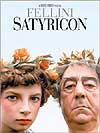 Examples:
Most of Fellini's films have an eye for the "grotesque", such
as Fellini - Satyricon (1970), Fellini's Roma (1972), Amarcord (1973), and City
of Women (1981) Examples:
Most of Fellini's films have an eye for the "grotesque", such
as Fellini - Satyricon (1970), Fellini's Roma (1972), Amarcord (1973), and City
of Women (1981) |
||
| a low-budget film usually shot without seeking location permits, using non-SAG (Screen Actors Guild) actors, etc. | Example: Student films | ||
| an escapist film that engenders low expectations (usually an awful B-movie or a critically-lambasted film) that the public enjoys despite or, more likely, because of its flaws; these are often quite personal film choices that are sometimes embarrassing to admit. Universally-loved 'guilty pleasure' films become cult films. See also flop and B-movie | 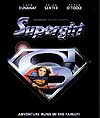 Examples:
Teen movies, various horror films, sappy romances, The Rocky Horror
Picture Show (1975), Kentucky Fried Movie (1977), Flash
Gordon (1980), Supergirl (1984), Cocktail (1988), Gamera:
The Guardian of the Universe (1995), Showgirls (1996), William
Shakespeare's Romeo + Juliet (1996), Anaconda (1997), Wild
Things (1998), and Lara Croft: Tomb Raider (2001) Examples:
Teen movies, various horror films, sappy romances, The Rocky Horror
Picture Show (1975), Kentucky Fried Movie (1977), Flash
Gordon (1980), Supergirl (1984), Cocktail (1988), Gamera:
The Guardian of the Universe (1995), Showgirls (1996), William
Shakespeare's Romeo + Juliet (1996), Anaconda (1997), Wild
Things (1998), and Lara Croft: Tomb Raider (2001) |
||
| a shot taken with a handheld camera or deliberately made to appear unstable, shaky or wobbly; often used to suggest either documentary footage, 'realism,' news reporting, cinema verite, or amateur cinematography; contrast with Steadicam | Frequently exaggerated and currently overused, such as in The Blair Witch Project (1999) | ||
| named after Will Hays, a series of rigid censorship restrictions imposed on films by the Motion Picture Production Code (MPPC) beginning in mid-1934, and enforced/administered by Joseph Breen (in the Breen Office); the code had existed since the late 1920s but wasn't vigorously enforced, and it basically lasted until the late 1960s; the Code explicitly prescribed what couldn't be shown in films, i.e., "nakedness and suggestive dances," "methods of crime," "alleged sex perversion," "illegal drug use," "scenes of passion," "excessive and lustful kissing...", "miscegenation," "pointed profanity," etc. | Examples: Film that were among the first to be censored for their alleged objectionable material included any of Mae West's works (I'm No Angel (1933)), Baby Face (1933), and the early Weissmuller/Maureen O'Sullivan film Tarzan and His Mate (1934) - which had its nude swimming scene cut; in later installments of the Tarzan/Weissmuller films, Jane's scanty clothing and nudity, and rampant sexuality with Tarzan, would disappear.
|
||
| a shot in which the action moves or comes directly toward or at the camera, to enhance the audience's feelings of participation; works well with 3-D films; also may refer to a head shot | |||
| a moving shot, often breathtaking; an establishing shot from a bird's eye view or from overhead, usually taken from a helicopter - due to its maneuverability, the shot may pan, arc, or sweep through a landscape; many films open with a helicopter shot (often under the credits) |  Examples:
the final shot from a Wonkavator high above the city's rooftops in Willy
Wonka & the Chocolate Factory (1971), or in The
Shining (1980) the trailing of a lone car driving through the
Rockies to the Overlook Hotel; Examples:
the final shot from a Wonkavator high above the city's rooftops in Willy
Wonka & the Chocolate Factory (1971), or in The
Shining (1980) the trailing of a lone car driving through the
Rockies to the Overlook Hotel;  or
in Working Girl (1988) the opening credits' long arcing shot
around the Statue of Liberty before trailing the Staten Island Ferry or
in Working Girl (1988) the opening credits' long arcing shot
around the Statue of Liberty before trailing the Staten Island Ferry |
||
| terms used to refer to the director (aka helmer) of a film | |||
| refers to the major male and female protagonists in a film with whom the audience identifies and sympathizes. Character traits often include being young, virtuous, handsome, pretty, etc.; contrast with the antagonist or heavy (the villain or evil force). |  The underdog hero, Rocky Balboa in Rocky (1976) |
||
| a shot in which the subject or scene is filmed from above and the camera points down on the action, often to make the subject(s) small, weak and vulnerable; contrast to low-angle shot | 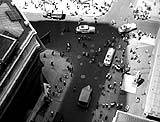 Example:
in the opening of Force of Evil (1948), a high-angle (overhead)
camera view of towering skyscrapers surrounding St. Andrew's Church near
Wall Street Example:
in the opening of Force of Evil (1948), a high-angle (overhead)
camera view of towering skyscrapers surrounding St. Andrew's Church near
Wall Street |
||
refers to the saleable or marketable elements of a film; a high concept (actually low-concept in practice) refers to a film's main premise expressed as a simple formula in just a few words (as a one-liner) that can be easily understood by all; this idea portrays a shallow, condescending attitude toward undiscriminating film audiences by Hollywood's marketers and often results in having film content controlled by what appeals to the lowest common denominator type market; see also logline (also known as premise) |
 Example:
A successful lawyer cheats on his wife with a beautiful psychopath,
in Fatal Attraction (1987); or fish-out-of-water Detroit cop
in Beverly Hills in Beverly Hills
Cop (1984); or a blue-collar welder during the day passionately
aspires to be a dancer at night, in Flashdance (1983) (above);
or the "gimmicky" pairing of improbable twins Arnold Schwarzenegger
and Danny DeVito in Twins (1988); or Braveheart (1995) -
an epic love story and swashbuckler on the Scottish battle plain Example:
A successful lawyer cheats on his wife with a beautiful psychopath,
in Fatal Attraction (1987); or fish-out-of-water Detroit cop
in Beverly Hills in Beverly Hills
Cop (1984); or a blue-collar welder during the day passionately
aspires to be a dancer at night, in Flashdance (1983) (above);
or the "gimmicky" pairing of improbable twins Arnold Schwarzenegger
and Danny DeVito in Twins (1988); or Braveheart (1995) -
an epic love story and swashbuckler on the Scottish battle plain |
||
| an on screen television image that will appear in a ratio of 16:9 compared to today's analog signal ratio of 4:3; the image will be 'high-def' due to increased lines of resolution (e.g., 1080 lines rather than the 525 of analog) | |||
| the use of thin beams of light to illuminate selected or limited parts of the subject (e.g., an actress' eyes) | |||
| slang term for the following verbs, meaning "to increase", "to raise" or "to promote" | |||
| an actor's term for moving to the correct, predetermined position during rehearsals and during camera takes so that the camera can smoothly record the action; 'mark' refers to pieces of crossed tape on the floor to signify positions | |||
| the term used by a director for an actor
used for an extra day |
|||
| usually a respectful tribute to someone or something; this often occurs within one movie when a reference is made to another film's scene, image, etc. | Examples: Woody Allen's Shadows and Fog (1991) pays tribute to German Expressionism and classic b/w horror films, including Cat People (1942) and Freaks (1932); also the final shot of The Grifters (1990), paying homage to The Maltese Falcon (1941) 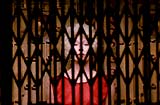 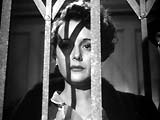 |
||
| a slang term denoting a dancer | Examples: 'hoofers' in Busby Berkeley's dance production numbers | ||
| a popular film genre designed to frighten and thrill with familiar elements (monsters, killers, vampires, zombies, aliens, mad scientists, the devil or demons, etc.), gothic qualities or settings (e.g., castles), psychological terror, etc.; initially influenced by German expressionism; subgenre types include slasher films, occult films, and gore-fests; often combined with the sci-fi genre | Examples: the Universal horror classics: Dracula (1931), Frankenstein (1931), The Mummy (1932), The Invisible Man (1933) | ||
| general slang for a western film, not for a "singing cowboy" film; also known as an oater (for the food that horses eat) | 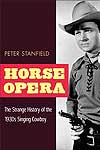 Examples: Stagecoach
(1939), My Darling Clementine (1946), Red
River (1948), High Noon (1952), Shane
(1953), The Searchers (1956), Ride the
High Country (1962), The Wild Bunch (1969),
Little Big Man (1970), Dances With Wolves (1990) Examples: Stagecoach
(1939), My Darling Clementine (1946), Red
River (1948), High Noon (1952), Shane
(1953), The Searchers (1956), Ride the
High Country (1962), The Wild Bunch (1969),
Little Big Man (1970), Dances With Wolves (1990) |
||
| a film or production that combines or intersects two or more distinct genre types, and cannot be categorized by a single genre type; see also cross-over | Examples: Little Shop of Horrors (1986) (musical plus horror); Westworld (1973) (sci-fi plus western); Blade Runner (1982) (sci-fi plus film noir); Who Framed Roger Rabbit? (animation plus film noir); | ||
| the abbreviation for hyperbole; refers to manufactured promotional buzz and excessive advertising/marketing for a film or project, including celebrity appearances, radio and TV spots or interviews, and other ploys; a similar word - hypo - means to increase or boost | |||